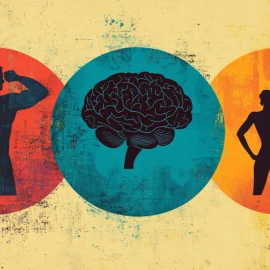

This article is an excerpt from the Shortform book guide to "Bittersweet" by Susan Cain. Shortform has the world's best summaries and analyses of books you should be reading.
Like this article? Sign up for a free trial here.
What’s the purpose of sadness? Why is sadness such an important emotion? Can sadness be beneficial?
Sadness is often seen as a negative emotion—something to be avoided or suppressed—but according to best-selling author Susan Cain, it serves a powerful purpose in our lives. In her book Bittersweet, Cain argues that sadness is a prosocial emotion that inspires compassion and empathy for others.
Read on to learn what the purpose of sadness is and why it’s so important, according to Cain.
What’s the Purpose of Sadness?
According to best-selling author Susan Cain, one of the primary emotions of a bittersweet existence is sadness. In her book Bittersweet, Cain presents sadness as a powerful emotion capable of inspiring much more than just pain—sadness can lead to positive experiences, too. So, what is the purpose of sadness?
Below, we’ll explain Cain’s views on the purpose of sadness as an emotion that inspires compassion for others.
(Shortform note: Note, in understanding the purpose of sadness, it’s important to know that there’s a distinction between sadness and depression. Sadness is an inevitable part of life, but it isn’t constant. Due to its temporary nature, it can help us slow down, consider what’s bothering us, and propel us to change our circumstances for the better. Depression involves severe sadness that lasts for more than two weeks and involves the loss of interest or pleasure in activities we normally enjoy. Additionally, it may cause symptoms such as low energy, loss of appetite, and insomnia. Depression may be triggered by a traumatic event or psychological stress, and genetic factors often predispose people to it.)
The Compassionate Power of Sadness
According to the author, though we often shy away from the pain of sadness, it’s actually one of our most important emotions. This is because sadness serves a purpose as a prosocial emotion, meaning it engenders compassion and empathy for other people. When we see someone who’s sad, we feel sad too, and we want to make it better. Since sadness inspires us to care for others and drives us to help others in response, it deepens our bonds.
(Shortform note: Many studies support Cain’s assertion about the purpose of sadness and that sadness has numerous prosocial benefits. Since sadness inspires empathy and compassion, it prompts others to respond to our needs. For example, participants in negotiations are more likely to yield to someone who’s sad than someone displaying another emotion like anger, because sadness triggers empathic concern.)
In her explanation of the purpose of sadness, Cain notes that sadness activates the same parts of our nervous systems regardless of whether we’re hurt or we witness the pain of someone else. Specifically, it activates the following parts of the brain:
The anterior cingulate cortex (ACC), which regulates our ability to complete complex tasks. This region activates when we experience pain and when we see someone else suffering. For example, your ACC would activate in the same way whether you stubbed your toe or you saw someone else stub their toe.
(Shortform note: The ACC plays an important role in a variety of cognitive functions: emotional regulation and awareness, decision-making and choosing what to pay attention to, pain management, anticipation, mistake detection, and autonomic nervous system responses (such as blood pressure regulation). This means it helps us identify emotions in others, affects how we deal with difficult emotions, and regulates how we respond emotionally to pain (not our physical perception of pain). All of these functions prime us to respond to painful emotions in others, like sadness.)
The periaqueductal gray (PAG), which drives mothers to take care of their young. (Shortform note: Studies show that the PAG plays an important role in mediating survival behaviors, caregiving behaviors, and responses to vocalizations in mammals. Some research also suggests that the PAG is part of the auditory pathway in our brains that helps us distinguish between infant vocalizations and other similar sounds. Thus, it helps initiate a rapid care response toward our young.)
The vagus nerve, which helps regulate reproduction, breathing, and digestion. Additionally, the vagus nerve fires whenever we see someone in pain, such as children who are being treated for cancer. This suggests that it has a strong role in prompting us to care about the suffering of others.
| Compassion and the Vagus Nerve Substantial research supports Cain’s assertion that activity in the vagus nerve is deeply tied to our compassionate response. In several studies, researchers found that both our depth of compassion for and motivation to help others directly correlate to the level of activity in our vagus nerve: People with more activity in their vagus nerve tend to show more compassion to others. Researchers measure activity in the vagus nerve using vagal tone, which represents the strength of our vagus nerve: Higher levels of activity mean a stronger vagal tone. They calculate vagal tone by analyzing how much our vagus nerve slows our heartbeat, using the difference between our heart rate during inhalation and exhalation: As we inhale, our heart beats faster, and as we exhale, the vagus nerve slows it down again. Without the slowing influence of the vagus nerve, our hearts would beat too fast. The stronger our vagal tone is, the more our vagus nerve slows our heartbeat, and the more compassionate we are toward others. |

———End of Preview———
Like what you just read? Read the rest of the world's best book summary and analysis of Susan Cain's "Bittersweet" at Shortform.
Here's what you'll find in our full Bittersweet summary:
- Why you should embrace a bittersweet disposition in life
- How sadness has the power to foster creativity and empathy
- How to accept your own mortality and the impermanence of life






